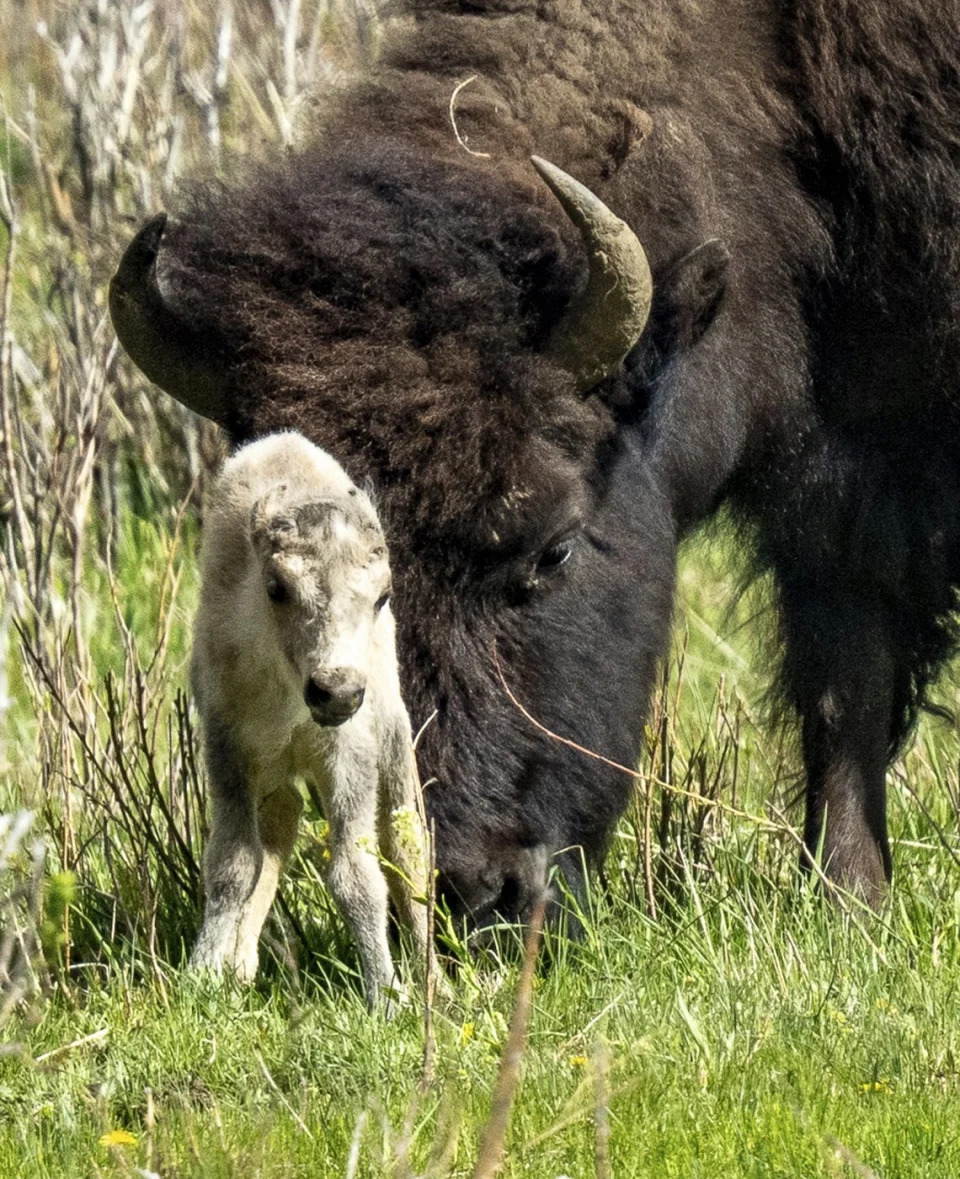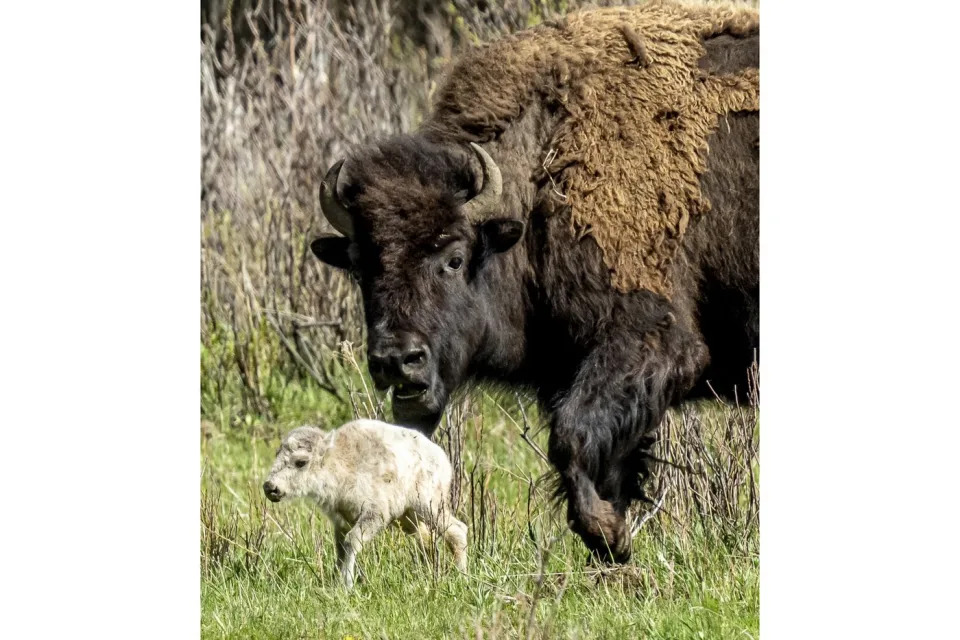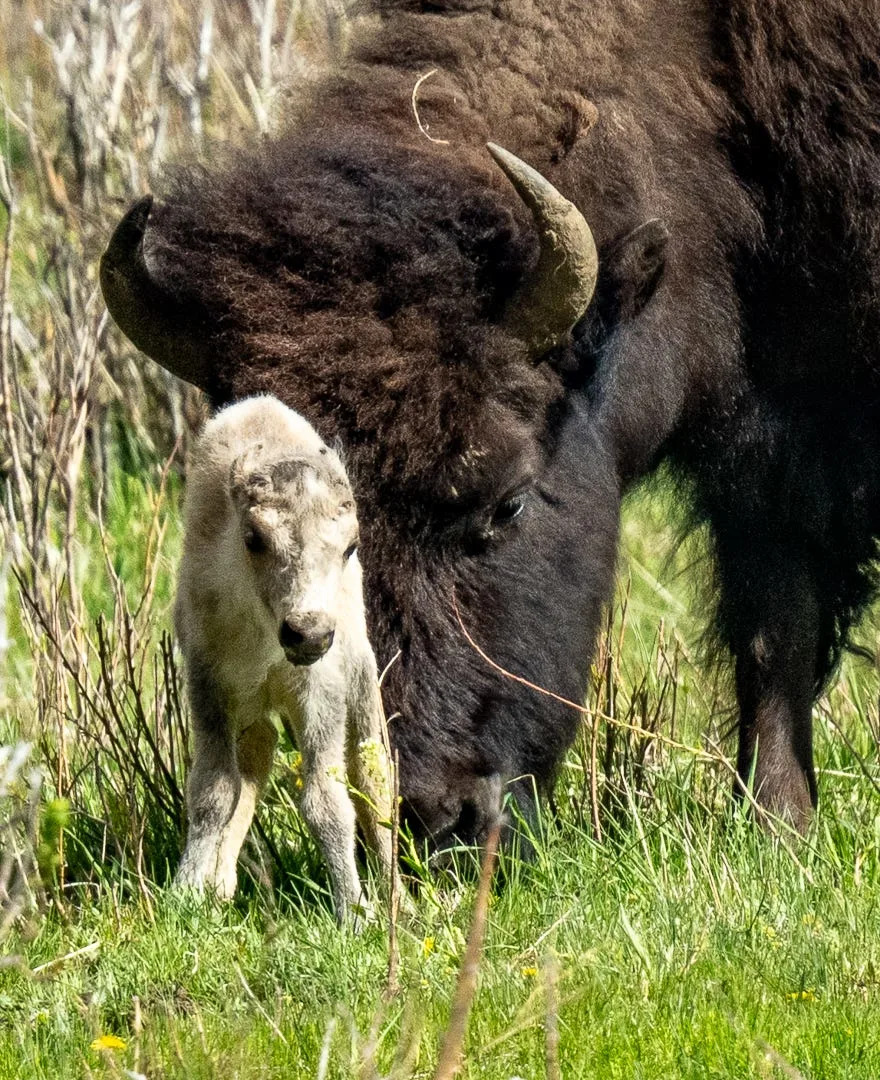Amy Beth Hanson
Thu, June 13, 2024


HELENA, Mont. (AP) — The reported birth of a rare white buffalo in Yellowstone National Park fulfills a Lakota prophecy that portends better times, according to members of the American Indian tribe who cautioned that it’s also a signal that more must be done to protect the earth and its animals.
“The birth of this calf is both a blessing and warning. We must do more,” said Chief Arvol Looking Horse, the spiritual leader of the Lakota, Dakota and the Nakota Oyate in South Dakota, and the 19th keeper of the sacred White Buffalo Calf Woman Pipe and Bundle.
The birth of the sacred calf comes as after a severe winter in 2023 drove thousands of Yellowstone buffalo, also known as bison, to lower elevations. More than 1,500 were killed, sent to slaughter or transferred to tribes seeking to reclaim stewardship over an animal their ancestors lived alongside for millennia.
Erin Braaten of Kalispell took several photos of the calf shortly after it was born on June 4 in the Lamar Valley in the northeastern corner of the park.
Her family was visiting the park when she spotted “something really white” among a herd of bison across the Lamar River.
Traffic ended up stopping while bison crossed the road, so Braaten stuck her camera out the window to take a closer look with her telephoto lens.
“I look and it's this white bison calf. And I was just totally, totally floored,” she said.
After the bison cleared the roadway, the Braatens turned their vehicle around and found a spot to park. They watched the calf and its mother for 30 to 45 minutes.
“And then she kind of led it through the willows there,” Braaten said. Although Braaten came back each of the next two days, she didn't see the white calf again.
For the Lakota, the birth of a white buffalo calf with a black nose, eyes and hooves is akin to the second coming of Jesus Christ, Looking Horse said.
Lakota legend says about 2,000 years ago — when nothing was good, food was running out and bison were disappearing — White Buffalo Calf Woman appeared, presented a bowl pipe and a bundle to a tribal member, taught them how to pray and said that the pipe could be used to bring buffalo to the area for food. As she left, she turned into a white buffalo calf.
“And some day when the times are hard again,” Looking Horse said in relating the legend, “I shall return and stand upon the earth as a white buffalo calf, black nose, black eyes, black hooves.”
A similar white buffalo calf was born in Wisconsin in 1994 and was named Miracle, he said.
Troy Heinert, the executive director of the South Dakota-based InterTribal Buffalo Council, said the calf in Braaten's photos looks like a true white buffalo because it has a black nose, black hooves and dark eyes.
“From the pictures I've seen, that calf seems to have those traits,” said Heinert, who is Lakota. An albino buffalo would have pink eyes.
A naming ceremony has been held for the Yellowstone calf, Looking Horse said, though he declined to reveal the name. A ceremony celebrating the calf's birth is set for June 26 at the Buffalo Field Campaign headquarters in West Yellowstone.
Other tribes also revere white buffalo.
“Many tribes have their own story of why the white buffalo is so important,” Heinert said. “All stories go back to them being very sacred.”
Heinert and several members of the Buffalo Field Campaign say they've never heard of a white buffalo being born in Yellowstone, which has wild herds. Park officials had not seen the buffalo yet and could not confirm its birth in the park, and they have no record of a white buffalo being born in the park previously.
Jim Matheson, executive director of the National Bison Association, could not quantify how rare the calf is.
“To my knowledge, no one’s ever tracked the occurrence of white buffalo being born throughout history. So I’m not sure how we can make a determination how often it occurs.”
Besides herds of the animals on public lands or overseen by conservation groups, about 80 tribes across the U.S. have more than 20,000 bison, a figure that’s been growing in recent years.
In Yellowstone and the surrounding area, the killing or removal of large numbers of bison happens almost every winter, under an agreement between federal and Montana agencies that has limited the size of the park’s herds to about 5,000 animals. Yellowstone officials last week proposed a slightly larger population of up to 6,000 bison, with a final decision expected next month.
But ranchers in Montana have long opposed increasing the Yellowstone herds or transferring the animals to tribes. Republican Gov. Greg Gianforte has said he would not support any management plan with a population target greater than 3,000 Yellowstone bison.
Heinert sees the calf's birth as a reminder “that we need to live in a good way and treat others with respect.”
“I hope that calf is safe and gonna live its best life in Yellowstone National Park, exactly where it was designed to be,” Heinert said.
___
Associated Press reporter Matthew Brown contributed to this story from Billings, Mont.
Amy Beth Hanson, The Associated Press
Photographer shares 'magical' photos of rare white bison calf at Yellowstone
Julia Gomez and Saleen Martin, USA TODAY
Wed, June 12, 2024 at 11:15 a.m. MDT·4 min read
A rare white bison spotted in Yellowstone National Park has social media users in awe.
Erin Braaten, an outdoor photographer from Kalispell, Montana, captured the animal on camera.
“It was pretty amazing,” she told USA TODAY on Tuesday, adding that she initially thought it was a coyote or something else. “It just seemed really odd for it to be there and we got stuck in traffic. And so I took my camera out and looked back and saw that it was actually a white bison calf that had just been born.”

A rare white bison spotted in Yellowstone National Park.
Her family was about 100 yards away from the bison. It was across a river that was flowing pretty quickly.
“They were able to experience it too,” she said. “It was just kind of a very neat, magical time for us all to see this.”
Braaten said she was equipped with her own camera that day since she was in Yellowstone. She usually keeps it on her when she’s in the area because she never knows what she’s going to see. She has even seen lots of bears in the area.
She said she sees cows in the area often, as well as bison. This is the first time she has seen a white bison though.

A rare white bison spotted in Yellowstone National Park.
White bison born in Wyoming last spring
The bison isn’t the first making headlines as of late.
Last spring, a white bison was born at Bear River State Park in Evanston, Wyoming.
Calling the new addition a “little white ball of fluff,” the white calf was born with four reddish-brown colored bison calves. The white bison calf is the first born in the 32-year-old park’s history.
How do the rare bison get their white color?
White bison appear the way they do typically because of albinism and leucism, conditions that can cause an animal to have white fur, hair, skin or feathers, according to the Alaska Department of Fish and Game. The conditions are caused by a lack of cellular pigments.
Leucism can cause the entire animal to appear white, or just patches. Albino animals typically have pink eyes while leucistic animals don’t.
White bison are typically albino, leucistic, meaning they have white fur with blue eyes, or beefalo, a bison-cattle crossbreed.
Native Americans consider white bison to be sacred, according to African Safari Wildlife Park. In fact, one social media user on Instagram came across the photographer’s post about the white bison and chimed in. "Thank you for these photos,” the Instagram user wrote. “You cannot imagine the meaning for us Lakota as a people.”
White bison are so rare that it’s estimated there are only one out of every 10 million bison births, according to the African Safari Wildlife Park.
The animals can weigh anywhere from 701 pounds to 2,200 pounds and they can measure 5-to-6 feet. White bison can live for 15 years in the wild or even 25 years in captivity, the safari park said on its website.
Photographer got to witness rare bison with her family
Braaten, who captured a photo of the most recent white bison calf in Yellowstone National Park, is a mother of eight children ranging from ages 16 to 30. She had three of her youngest children with her that day.
Her family had been camping for a week and each day, they went to different sections of the park. They were in Lamar Valley, where people often see wolves and different animals. They spotted the white bison on their first day.
She said she’s a little surprised to see the reaction her photos have received.
They live close to Glacier National Park and she first got into photography taking family photos and photos of her family’s farm.
“I started doing landscapes and then wildlife,” she said. “People just enjoy them and so it has just kind of grown … It’s great therapy.”
Keep up with Braaten’s photography at www.facebook.com/DancingAspensPhotography and www.instagram.com/dancing_aspens_photo.
Contributing: Camille Fine
Saleen Martin is a reporter on USA TODAY's NOW team. She is from Norfolk, Virginia – the 757. Follow her on Twitter at @SaleenMartin or email her at sdmartin@usatoday.com.
This article originally appeared on USA TODAY: White bison calf spotted at Yellowstone: See photos
No comments:
Post a Comment